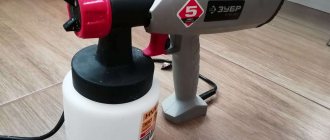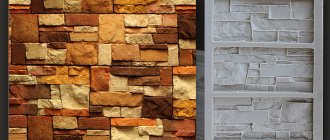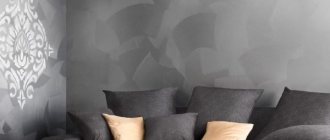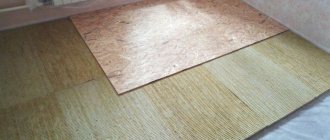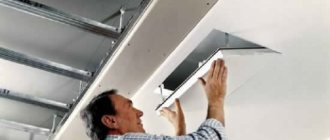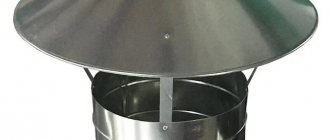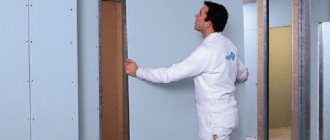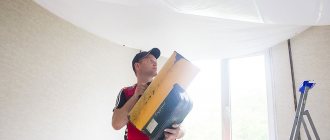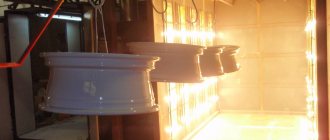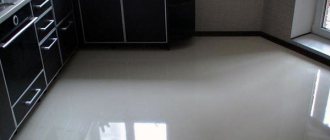Repair work often involves painting various surfaces. To save time and get an even result, you can use a spray gun. But having this device in the house is not always possible; in such cases, you can build it from improvised means. You can make a spray gun with your own hands from a vacuum cleaner, and this does not require a lot of time and skills. This process will be discussed in more detail below.
Spray gun for vacuum cleaner: description
The spray gun for a vacuum cleaner is a design with a tank for coloring agents, located on top, ensuring a uniform supply of paint. Through a special hole, the paint and varnish material enters the spray gun. Its spraying occurs due to the air flow coming from the operation of the vacuum cleaner.
A homemade spray gun attachment for a vacuum cleaner is made from an ordinary lid for cans, covering an existing container with a volume of up to a liter. The hole on the lid should have a diameter of 30 millimeters; if there is no such hole, you can use a special adapter. This design is easy to make and is convenient for painting work.
The spray gun for a vacuum cleaner is a design with a tank for coloring agents, located on top, ensuring a uniform supply of paint.
Operating principle of an air spray gun
To make it easier to build a properly working sprayer for a vacuum cleaner, it is useful to understand the operating principle of a factory paint sprayer. The spray gun operates using compressed air, so it requires a device that ensures this movement. In this case, this role is performed by a special compressor; its operation is carried out using gasoline or the electrical network.
Pneumatic spray guns work with powerful compressors, usually having large volumes of receivers - up to 30 liters, and are semi-stationary devices. Also on sale you can choose options with a smaller receiver volume; they are conveniently mounted on the shoulder. When it comes to a compressor in the form of a vacuum cleaner, then the lightweight second option is suitable, because you will get a low-pressure spray gun for a vacuum cleaner, while in pneumatics the pressure is higher.
Speaking about the structure of the sprayer itself, it must be said that it consists of a body with a trigger, a needle, a nozzle, a spray part and a lower container. By pressing the trigger, the master moves the needle, the cone-shaped tip of which closes the flow of paint from the nozzle. There are two tubes in the container: short and long. The first is necessary for air penetration, the second for the supply of coloring agent. Due to air pressure, the liquid is pushed out of the container and exits through the nozzle; part of the air ends up in the channels of the air cap, subsequently following the liquid and breaking it into smaller fractions.
The spray gun operates using compressed air.
Types of spray guns for vacuum cleaners
In Soviet times, special sprayers for vacuum cleaners were sold; such a convenient rarity is almost impossible to find on sale at the moment. But modern analogues have appeared on the market.
So you need to purchase a spray nozzle for the vacuum cleaner. You can find such a spare part on sale. a part that is intended for an electric spray gun with a remote compressor.
In total such app. parts go on sale from two brands “ZUBRA” and “WAGNER”. Apart from these companies, no one else produces ready-made versions of sprayers separately.
You will need to purchase a spray nozzle for your vacuum cleaner.
Making a spray gun with your own hands
Making a sprayer for painting with your own hands is very simple. To do this, it is enough to use an old vacuum cleaner, as well as improvised materials that can be found in the house. The most important thing is to get a spray gun - this is a tool similar to a gun that is used to spray paint.
To connect the spray gun from a vacuum cleaner, reverse draft is necessary (i.e., the vacuum cleaner motor must supply air for blowing). Unfortunately, most modern models do not have this capability.
The Raketa 12A model vacuum cleaner was popular in the USSR. The device had a special nozzle in the form of a spray cap, which was placed on a glass container. We talked about this version of the sprayer above. Nowadays, it is difficult to purchase such an attachment, just as it is difficult to find a vacuum cleaner with reverse draft in stores, but both of these devices are easy to make on your own.
To make an electric sprayer, the first step is to get an old or unnecessary vacuum cleaner that you don’t mind disassembling. It would be better if it was Rocket 12A, but a more modern model would also be suitable.
The direction of the air masses in the hose is changed so that the impeller supplies air rather than sucking it in, as during normal operation. In order to make a spray gun from a vacuum cleaner, you need to change the direction of rotation of the impeller blades in the opposite direction. To achieve this, it is enough to reverse the polarity of the power terminals going to the stator and rotor.
Next, it is necessary to achieve a constant pressure sufficient for the compressor to pump up the missing volume of air to atomize the thick liquid (change in the functioning of the impeller). If the blades move in the opposite direction, the air masses will change their direction with an equally proportional force.
If the position of the blades is asymmetrical, this will lead to a decrease in reverse thrust. Therefore, it is better to purchase a more suitable impeller.
When modifying an engine, two important criteria should be taken into account:
- Type of impeller blade design;
- Possibility of turning the engine in reverse direction.
If both of these criteria are met, you should look for a spray cap.
Maybe someone you know has a similar attachment lying around - in the past, such a paint sprayer was supplied complete with a vacuum cleaner. You can also take advantage of online advertisements; there are also master classes on how to make a homemade sprayer.
The most difficult step is choosing the right pressure reducing valve for the spray. To do this, put the valve on the hose and make an outlet for the incoming liquid on the lid (and maintain a tight seal). In addition to all of the above, you will need an air duct, with its help air masses will enter the tank, thereby replacing the lost volume of liquid (paint or lime).
Important! When first testing a spray gun, it is best to use water-based paint.
On video: master class on making a spray gun.
Which vacuum cleaner to use
When choosing a vacuum cleaner that is suitable for painting work as an air blower, first of all, we focus on power. If there is not enough power, then the spraying will not work well enough. Also, the vacuum cleaner must have a special channel; if it is missing, they resort to closing all existing holes in the device so that suction occurs only from one place where the hose will be attached.
Options for vacuum cleaners that already have the necessary hole are the old Soviet models “Ural”, “Pioneer” and others. Among the new models we can note the Samsung SC4140.
But you can make do with the available equipment; this will be discussed later.
When choosing a vacuum cleaner that is suitable for painting work as an air blower, first of all, we focus on power.
Features of using a vacuum cleaner as a sprayer
In order to apply whitewash or water-based paint to the ceiling by spraying, you need a special device called a spray gun or spray gun. Its operating principle is based on the fact that air, pumped by a third-party device, comes out under pressure from the spray nozzle and draws out paint particles that settle in a thin layer on the surface of the ceiling.
The spray gun can be either an independent element equipped with an air blower, or it can be made in the form of an attachment that fits onto a third-party device, such as a compressor, vacuum cleaner or hand sprayer. However, using some models of vacuum cleaners as a spray gun will not be possible if:
- The vacuum cleaner cannot generate backdraft or there is no blowout hole in its body to connect the hose. Many modern vacuum cleaners are simply not designed to generate outgoing air flow.
- The unit must be powerful enough to provide uniform spraying. Considering the design features of many vacuum cleaners, their reverse draft power is usually less than that of forward draft.
- In this regard, whitewashing with a vacuum cleaner is usually carried out using old “Soviet” equipment, or using more modern models, but with a modified engine connection diagram.
Advantages of a homemade device
An obvious positive factor of such a device is its low cost. You can make it from scrap materials; you don’t need to buy a lot of them. The homemade version copes well with the task and can significantly facilitate painting work. This attachment is also suitable for whitewashing a vacuum cleaner. In addition, if the device is manufactured correctly, it will be able to spray water-based and acrylic paints well, which factory sprayers cannot always spray.
The homemade version copes well with the task and can significantly facilitate painting work.
How to make
If you happen to have a special attachment at hand that came with Soviet vacuum cleaner models, then this is the fastest and easiest option. It is simply put on a liter jar. Next, the outlet hole is adjusted to the desired parameters. And the edge of the hose from the vacuum cleaner is adjusted to the air inlet to the sprayer; if necessary, an adapter is used to adjust the holes to each other. Other manufacturing options are described below.
The edge of the hose from the vacuum cleaner is adjusted to the air inlet to the sprayer.
Preparing the vacuum cleaner
First you need to remove the dust collectors in the device, no matter what they are. The remaining parts of the device need to be wiped and cleaned of dirt. Also, in the room where the paint sprayer for the vacuum cleaner will be assembled, wet cleaning should be carried out.
The room where the paint sprayer for the vacuum cleaner will be assembled should be wet cleaned.
Required parts and tools
To create this unit you will need the following tools and accessories:
- Vacuum cleaner;
- Receiver, a rubber inner tube or a ball is suitable for this purpose;
- Container where the paint will be poured;
- Reducing valve;
- Fasteners
To create this unit you will need special tools and devices.
Manufacturing process
It is necessary to change the direction of thrust in the old device. To do this, the engine should be forced to move in the other direction. You can reverse the terminals going to the rotor and stator. But still, the impeller blades will influence the traction force. If they have an asymmetrical shape, then it is better to change them to a version with symmetrical blades.
Then they proceed to preparing the required pressure on the sprayer. To do this, you need to perform one of the options for preparing any type of existing vacuum cleaner for work:
- All existing holes must be closed; for this purpose, polyurethane foam, hot melt adhesive, epoxy resin and other means are used that can ensure reliable sealing. At the blowing point, make a round hole suitable for the hose. Next, a piece of PVC pipe is placed in it; it should be left outside by about seven centimeters. This option is suitable for an old device that you don’t mind;
- A more humane method in relation to the device. You need to prepare a large, thick bag and a second hose. The vacuum cleaner itself is placed in a bag, and the hose from it is led out, it closes tightly; electrical tape is suitable for this. Thus, the air will circulate in the bag and then exit through the second hose. For the process to go smoothly, the bag must be reliable, and all holes must be properly sealed.
Then the device is cleaned, 150 grams of solvent is poured into the container, and the vacuum cleaner is turned on for ten minutes.
It is necessary to change the direction of thrust in the old device.
Testing and operating rules
You need to test the device first. To do this, it is advisable to paint a small area of the surface on the street, and you need to keep it at a distance of 20 cm from the object. It is better to keep the nozzle diameter to a minimum.
Operating rules:
- The coloring agent must be strained;
- The conductive channels are washed before and after work;
- Do not allow the spray unit to turn over during the painting process.
Do not allow the spray unit to turn over during the painting process.
Features of whitewashing the ceiling using a vacuum cleaner
If you have a vacuum cleaner of a suitable model and find a special attachment, you can assemble a homemade spray gun and start whitewashing. It is important that all parts of the sprayer, especially if a homemade device is used, are tightly connected to each other. When applying the solution, the sprayer must be kept at a distance of 50 - 80 cm from the ceiling, perpendicular to its surface.
The optimal distance is selected experimentally and depends on the density of the solution and the pressure of the injected air.
A pressure of 3 - 4 atmospheres is considered close to ideal with an average density of the solution. If the whitewash is thick enough, then the pressure should be increased, and for a solution that is too thin, on the contrary, reduced. The distance to the surface to be treated should not exceed 1 meter to avoid excessive dispersion of the solution, and should not be less than 0.5 meter to prevent the formation of drips.
Applying the solution to the ceiling using a sprayer, as shown in the video, is carried out in an even thin layer in small areas. To achieve the best result, it is recommended to apply several layers of whitewash, with each subsequent layer being sprayed onto a dry surface.
Tips for use
You should start working with inconspicuous areas of the surface to be painted in order to be able to get used to the device. The more layers you make and the thinner they are, the better the result. When painting the main part of the surface, you need to move quickly horizontally, this way it’s easier to avoid smudges.
The more layers you make and the thinner they are, the better the result.
An attachment to a vacuum cleaner for painting can make the job much easier; doing it yourself is not that difficult. If you have a suitable vacuum cleaner, this process will not take much time. And the result will please the owner.
Spray gun or roller?
Many craftsmen who do their own renovations in their apartments use ordinary rollers. But hand painting has several disadvantages when compared to using a spray gun. For example, the smoothness and thinness of the coating that a special sprayer gives cannot be achieved using a roller.
But this is far from the only positive side of using a spray gun. When used correctly, the surface will be neat and smooth. This effect cannot be achieved when using a roller, which often leaves lint and other imperfections. This debris deposit, which is very difficult to get rid of, is often very noticeable and spoils the overall impression of the renovation.
In addition, do not forget that the spray gun makes it possible to apply paint not only thinly, evenly and accurately, but also as quickly as possible. For people who value their time, this is an important plus. You can also forget about the need to thoroughly clean the space around the surface being treated. When using a roller, situations often occur when paint drips onto the floor, remains on furniture, etc. The spray gun makes it possible to carry out the surface painting procedure much more accurately. However, especially valuable things and items that cannot be washed afterwards should be put away. During the use of the device, a cloud of paint particles often forms, which can settle not only on the surface being painted, but also beyond it. However, when using spray gun attachments, you can achieve excellent results, and the cleanup after painting work will be minimal.
